The National Railway Company of Belgium is the national railway company of Belgium. The company formally styles itself using the Dutch and French abbreviations NMBS/SNCB. The corporate logo designed in 1936 by Henry van de Velde consists of the linguistically neutral letter B in a horizontal oval.
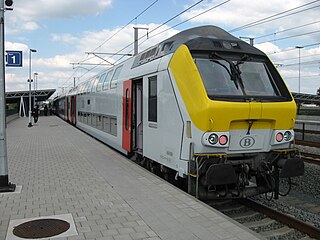
Belgium has an extensive rail network. It is a member of the International Union of Railways (UIC). The UIC Country Code for Belgium is 88.

The Iron Rhine or Steel Rhine is a partially nonoperational freight railway connecting the port of Antwerp (Belgium) and Mönchengladbach (Germany) by way of Neerpelt and the Dutch towns of Weert and Roermond.

Gent-Sint-Pieters railway station is the main railway station in Ghent, East Flanders, Belgium, and the fourth-busiest in Belgium and busiest in Flanders, with 17.65 million passengers a year. The station is operated by the National Railway Company of Belgium (NMBS/SNCB).

Antwerpen-Centraal railway station is the main railway station in Antwerp, Belgium. It is one of the most important hubs in the country and is one of the four Belgian stations on the high-speed rail network. From 1873 to early 2007, it was a terminal station. The current building, designed by the architect Louis Delacenserie, was constructed between 1895 and 1905. On 23 March 2007, a tunnel with two continuous tracks was opened under part of the city and under the station. The train services are operated by the National Railway Company of Belgium (NMBS/SNCB).

Infrabel is a Belgian government-owned public limited company. It builds, owns, maintains and upgrades the Belgian railway network, makes its capacity available to railway operator companies, and handles train traffic control.

Gent-Dampoort railway station is the second largest railway station in Ghent, East Flanders, Belgium. It is situated in the Dampoort neighbourhood, after which it is named.

Class 27 were the first of the Belgian Railways' large 1980s family of 144 electric locomotives. The family was made up of Classes 11 (12), 12 (12), 21 (60) and 27 (60). Classes 11, 12 and 21 were nearly twice as powerful as the preceding classes 22, 23 and 25. Class 27 was more than twice as powerful as these 1950s locomotives. The family was heavily influenced by the Class 202 locomotives built in the mid 1970s. They are very reliable because of the trial and error development of their predecessors. This family came into service with M4 and M5 coaching stock and the AM 80 and AM 86 series of EMUs. This generation was a major modernisation even if the older M2 coaching stock remained active for more than a decade. These four sister classes are visually identical except for a few minor details. Class 11's livery was specific to the Benelux service, which they operated for most of their service lives.

Class 15 is a type of electric locomotive operated by SNCB/NMBS. The locomotives were originally used for cross-border services TEE services between France, Belgium and the Netherlands, and, like the class 16, they became surplus after the introduction of Thalys and Class 11s. They earned their keep in their last years of service by pulling commuter "P" trains in the Liège area.
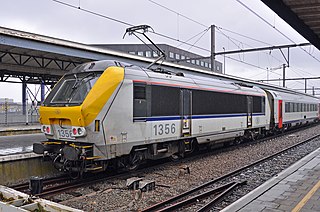
The Class 13 are a type of mixed use 200 km/h (124 mph) multivoltage electric locomotive of type Traxis designed by Alstom in the late 1990s for the Belgian and Luxembourgish railways.
Line 80 is a Luxembourgian railway line connecting Rodange to Belgium. It is designated Chemins de Fer Luxembourgeois, but predominantly operated by NMBS/SNCB. The services overlap with those designated as Line 70. On the Belgian side of the border the routes are numbered in the NMBS/SNCB series.
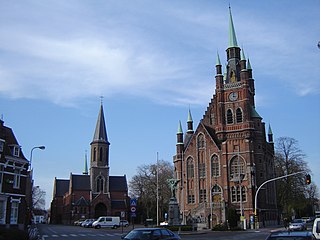
Sint-Amandsberg is a sub-municipality of the city of Ghent located in the province of East Flanders, Flemish Region, Belgium. The municipality of Sint-Amandsberg was formed in 1872, when it was detached from the municipality of Oostakker. In 1876 and 1900, parts of the original municipality were already annexed to Ghent. On 1 January 1977, the municipality of Sint-Amandsberg was merged into Ghent.

Leuven railway station is the main railway station in Leuven, Flemish Brabant, Belgium. The station is operated by the National Railway Company of Belgium (NMBS/SNCB) and is located on railway line 36. In 2007, it was the fifth-busiest station in Belgium, only preceded by the three main Brussels stations and Gent-Sint-Pieters railway station.
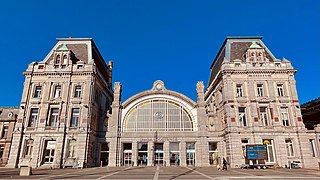
Oostende railway station is a railway station in Ostend, West Flanders, Belgium. It is operated by the National Railway Company of Belgium (NMBS/SNCB).
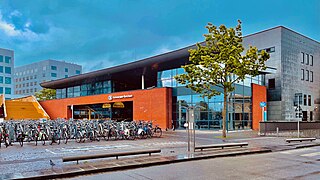
Antwerpen-Berchem railway station is a railway station in Berchem, in the south of Antwerp, Belgium. The station opened on 1 March 1865 and currently serves railway lines 25, 27, 27A and 59. The train services are operated by the National Railway Company of Belgium (NMBS/SNCB).

The Belgian State Railways Type 7, later known as the NMBS/SNCB Type 7, was a class of 4-6-0 compound locomotives built between 1921 and 1924.

The Belgian State Railways Type 10, later known as the NMBS/SNCB Type 10, was a class of 4-6-2 steam locomotives built between 1910 and 1914.

The Belgian State Railways Type 23, later known as the NMBS/SNCB Type 53, was a class of 0-8-0T steam locomotives built between 1904 and 1927.

The class 96 is an electric multiple unit constructed in 1996 for the National Railway Company of Belgium.
This page is based on this
Wikipedia article Text is available under the
CC BY-SA 4.0 license; additional terms may apply.
Images, videos and audio are available under their respective licenses.

















